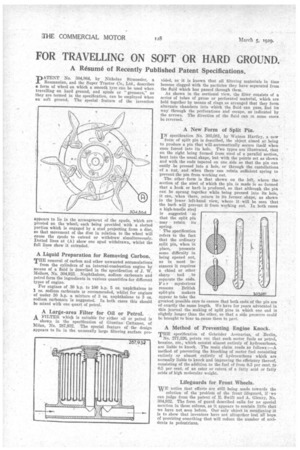FOR TRAVELLING ON SOFT OR HARD GROUND.
Page 70

If you've noticed an error in this article please click here to report it so we can fix it.
A Résumé of Recently Published Patent Specifications,
pATENT No. 304,864, by Nicholas Stranssler, a Roumanian, and the Super Tractor Co., Ltd., describes a form of wheel on which a smooth tyre can be used when travelling on hard ground, and spuds or " grousers," as they are termed in the specification, can be employed when on soft ground. The special feature of the invention
appears to lie in the arrangement of the spuds, which are pivoted on the wheel, each being provided with a slotted portion which is engaged by a stud projecting from a disc, so that movement of the disc in relation to the wheel will cause the spuds to extend or withdraw simultaneously. Dotted lines at (A) show one spud withdrawn, whilst the full lines show it extended.
A Liquid Preparation for Removing Carbon..
THE removal of carbon and other unwanted accumulations from the cylinders of an internal-combustion engine by means of a fluid is described in the specification of J. W. Ateliers, No. 304,923. Naphthalene, sodium carbonate and petrol form the ingredients in various quantities for different types of engine.
For engines of 30 h.p. to 100 h.p. 5 oz. naphthalene to 1 oz. sodium carbonate is recommended, whilst for engines of under 30 h.p. a mixture of 3 oz. naphthalene to 3 oz. sodium carbonate is suggested. In both cases this should be mixed with one quart of petrol.
A Large-area Filter for Oil or Petrol. _ A. FILTER which is suitable for either oil or petrol is shown in the specification of Giustino Cattaneo, of Milan, No. 287,932. The special feature of the design appears to lie in the unusually large filtering surface pro
vided, as it is known that all filtering materials in time become clogged with the particles they have separated from the fluid which has passed ,through them.
As shown in the sectional view, the filter consists of a series of tubes of gauze or perforated material, which are held together by means of rings so arranged that they form. alternate chambers into which the fluid can pass, find its way through the perforations and escape, as indicated by the arrows. The direction of the fluid can in some cases be reversed.
A New Form of Split Pin.
IN specification No. 303,081, by Watson Hartley, a new
form of split pin is described, the object aimed at being to produce a pin that will .automatically secure itself when once forced into its hole. Two types are illustrated, that on the right being formed from steel of a 'parallel section, bent into the usual shape, but with the points set as shown and with the ends tapered on one side so that the pin can easily be pressed into a hole, or through the.castellations of a nut, and when there can retain sufficient spring to prevent the pin from working out.
The other form is that shown on the left, where the section of the steel of which the pin is made is so formed that a hook, or barb is produced, so that .although the pin can he sprung together while being pressed into its hole, it can, when there, return to its former shape, as shown in the lower left-hand view, where it will be seen that the barb will prevent it from working out. In both cases a high-tensile steel is suggested so that the split pin may retain its spring.
The specification refers to the fact that the ordinary split pin, when in place, presents some difficulty in being opened out, as in most instances it requires a chisel or other sharp tool to separate the ends. F o r mysterious reasons British split-pin makers appear to take the
greatest possible care to ensure that both ends of the pin are of exactly the same length. We have for years advocated in this journal the making of split pins in which one end is slightly longer than the other, so that a side pressure could be brought to bear tocause them to part.
A Method of Preventing Engine Knock.
TEE specification of Gebriider Avenarius, of Berlin,
No. 277,326, points out that such motor fuels as petrol, benzine, etc., which consist almost entirely of hydrocarbons, are liable to knock. The main claim reads as follows :—A method of preventing the knocking of motor fuel consisting entirely or almost entirely of hydrocarbons which are normally liable to knock and improving the efficiency thereof, consisting of the addition to the fuel of from 0.3 per cent. to 0.5 per cent, of an ester or esters, of a fatty acid or fatty acids of high molecular weight.
Lifeguards for Front Wheels.
WE notice that efforts are still being made towards the solution of the problem of the front lifeguard, if we can judge from the patent of E. Swift and A, Gleuny, No. 304,932. The form of guard described calls for no special mention in these colums, as it appears to contain little that we have not seen before. Our only object in mentioning it is to show that inventors have not altogether lost all hope of providing something that will reduce the number of accidents to pedestrians.












































































































